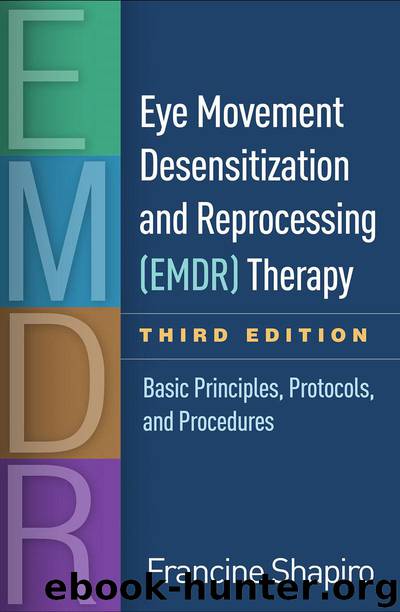Eye Movement Desensitization and Reprocessing (EMDR) Therapy, Third Edition by Shapiro Francine

Author:Shapiro, Francine [Shapiro, Francine]
Language: eng
Format: azw3
ISBN: 9781462535514
Publisher: Guilford Publications
Published: 2017-11-27T16:00:00+00:00
EDUCATION
The third plateau to be addressed is the ability to make adequate and life-enhancing choices in the present and in anticipation of the future. Clearly, for many clients, the experience of childhood is one of relative powerlessness, dependence on a dysfunctional family, and attacks by an adult that she had no means of resisting. In general, a client’s childhood emotional experience of lacking safety and alternatives is an accurate one. Part of the EMDR treatment is to resolve the past affect, including feelings of low self-worth, and to allow the client to embrace an appropriate sense of adult power in the present. For instance, with female clients who have reprocessed early memories of molestation, experiences that have resulted in a fear of men and an inability to forge lasting romantic relationships, the clinician might ask, “How do these words sound: ‘As an adult I can now choose who I want to be with.’ ” Even tentative approval from such a client is sufficient to start successive sets focusing on any feelings of fear or tension that may exist. Additional sets may focus on the new behavior to be actualized.
Clearly, in many instances, it is necessary to educate the client about social skills, assertiveness, dating customs, and so forth. These can be addressed by helping the client to understand the information at a cognitive level and to imagine the concomitant behavior (actions that would naturally result from such understanding). After this, successive sets should be initiated. As described in Chapter 8, this procedure helps clients to actualize the material before attempting it in real life. However, this incorporation of a positive template for appropriate future action cannot generally be inaugurated until the residual primary fears related to the early childhood events have been metabolized. Little behavioral headway can be made until the client feels himself to be at or near a VOC level of 7 concerning the statement, “As an adult, I can choose.” The clinician should identify for appropriate targeting any blocking beliefs that prevent the attainment of a VOC of 7. However, if the client reports a VOC of 6 (or less) because deficits in her background are causing her to feel too unskilled or inexperienced to cope successfully with a projected situation, the clinician should recognize this as an ecologically appropriate response and initiate the appropriate education.
The cognitive interweave may be used extensively in the educational process as the clinician alternates sets with instructional and imaginal material. The clinician can offer specific instructions regarding a task, ask the client to imagine it, then add the sets. However, as in all EMDR processing, the clinician must be prepared for the possibility that the client will remember an earlier event that is connected with some level of disturbance. If this occurs, the memory should become a primary target and education suspended until the memory has been thoroughly reprocessed.
The cognitive interweave allows the clinician to become more creative by including his usual clinical interventions and skills within the EMDR framework. For
Download
This site does not store any files on its server. We only index and link to content provided by other sites. Please contact the content providers to delete copyright contents if any and email us, we'll remove relevant links or contents immediately.
Periodization Training for Sports by Tudor Bompa(8167)
Why We Sleep: Unlocking the Power of Sleep and Dreams by Matthew Walker(6618)
Paper Towns by Green John(5086)
The Immortal Life of Henrietta Lacks by Rebecca Skloot(4523)
The Sports Rules Book by Human Kinetics(4288)
Dynamic Alignment Through Imagery by Eric Franklin(4115)
ACSM's Complete Guide to Fitness & Health by ACSM(3987)
Kaplan MCAT Organic Chemistry Review: Created for MCAT 2015 (Kaplan Test Prep) by Kaplan(3938)
Introduction to Kinesiology by Shirl J. Hoffman(3720)
Livewired by David Eagleman(3680)
The Death of the Heart by Elizabeth Bowen(3550)
The River of Consciousness by Oliver Sacks(3533)
Alchemy and Alchemists by C. J. S. Thompson(3447)
Bad Pharma by Ben Goldacre(3350)
Descartes' Error by Antonio Damasio(3229)
The Emperor of All Maladies: A Biography of Cancer by Siddhartha Mukherjee(3061)
The Gene: An Intimate History by Siddhartha Mukherjee(3046)
The Fate of Rome: Climate, Disease, and the End of an Empire (The Princeton History of the Ancient World) by Kyle Harper(3003)
Kaplan MCAT Behavioral Sciences Review: Created for MCAT 2015 (Kaplan Test Prep) by Kaplan(2935)
